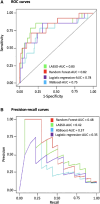Supervised machine learning including environmental factors to predict in-hospital outcomes in acute heart failure patients
- PMID: 40110211
- PMCID: PMC11914725
- DOI: 10.1093/ehjdh/ztae094
Supervised machine learning including environmental factors to predict in-hospital outcomes in acute heart failure patients
Abstract
Aims: While few traditional scores are available for risk stratification of patients hospitalized for acute heart failure (AHF), the potential benefit of machine learning (ML) is not well established. We aimed to assess the feasibility and accuracy of a supervised ML model including environmental factors to predict in-hospital major adverse events (MAEs) in patients hospitalized for AHF.
Methods and results: In April 2021, a French national prospective multicentre study included all consecutive patients hospitalized in intensive cardiac care unit. Patients admitted for AHF were included in the analyses. A ML model involving automated feature selection by least absolute shrinkage and selection operator (LASSO) and model building with a random forest (RF) algorithm was developed. The primary composite outcome was in-hospital MAE defined by death, resuscitated cardiac arrest, or cardiogenic shock requiring assistance. Among 459 patients included (age 68 ± 14 years, 68% male), 47 experienced in-hospital MAE (10.2%). Seven variables were selected by LASSO for predicting MAE in the training data set (n = 322): mean arterial pressure, ischaemic aetiology, sub-aortic velocity time integral, E/e', tricuspid annular plane systolic excursion, recreational drug use, and exhaled carbon monoxide level. The RF model showed the best performance compared with other evaluated models [area under the receiver operating curve (AUROC) = 0.82, 95% confidence interval (CI) (0.78-0.86); precision-recall area under the curve = 0.48, 95% CI (0.42-0.5), F1 score = 0.56). Our ML model exhibited a higher AUROC compared with an existing score for the prediction of MAE (AUROC for our ML model: 0.82 vs. ACUTE HF score: 0.57; P < 0.001).
Conclusion: Our ML model including in particular environmental variables exhibited a better performance than traditional statistical methods to predict in-hospital outcomes in patients admitted for AHF.
Study registration: ClinicalTrials.gov identifier: NCT05063097.
Keywords: Acute heart failure; Carbon monoxide; Environmental factors; Intensive cardiac care unit; Machine learning; Recreational drugs.
© The Author(s) 2024. Published by Oxford University Press on behalf of the European Society of Cardiology.
Conflict of interest statement
Conflict of interest: None declared.
Figures





References
-
- Crespo-Leiro MG, Anker SD, Maggioni AP, Coats AJ, Filippatos G, Ruschitzka F, et al. European Society of Cardiology Heart Failure Long-Term Registry (ESC-HF-LT): 1-year follow-up outcomes and differences across regions. Eur J Heart Fail 2016;18:613–625. - PubMed
-
- McDonagh TA, Metra M, Adamo M, Gardner RS, Baumbach A, Böhm M, et al. 2021 ESC guidelines for the diagnosis and treatment of acute and chronic heart failure. Eur Heart J 2021;42:3599–3726. - PubMed
-
- McDonagh TA, Metra M, Adamo M, Gardner RS, Baumbach A, Böhm M, et al. 2023 focused update of the 2021 ESC guidelines for the diagnosis and treatment of acute and chronic heart failure. Eur Heart J 2023;44:3627–3639. - PubMed
Associated data
LinkOut - more resources
Full Text Sources
Medical
Research Materials
Miscellaneous
